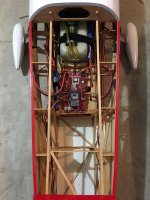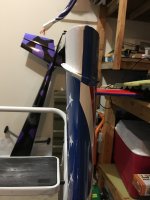Looking at the tray in the fuselage does not look like it does the job to well. Still looking at it and have not made up my mind what to do. But lucky you mentioned it because I laid it in place and then realize I could not get to the wing bolts that I have added to the inside of the fuselage. So will have to sort that out first and when that is done I will have to figure out how to do the tray it looks like I will,have to do a front and rear tray so that I can get my hands into the fuselage to do up the wing bolts.
@Snoopy1 since I used the original bolt through the tube method, that was not an issue I had. Like you say you could make a front and rear tray to clear your bolt positions. I would just be concerned about moving things too far back as you may run into balance issues. I managed to need no weights at all (always a goal of mine) and utilised receiver and ignition batteries to achieve the balanced outcome. I have attached some photos of the area for you to see what I did. The tray does add some stability to the structure, but a split tray will also achieve the outcome.
A couple of other points while I think of them:
1. The stab tube in the fuselage should butt up against the former that is just in front of it. Make sure you get a good glue joint there. If I were to make mine again, I would likely add a small sub former behind the stab tube to help distribute load from the tube to the fuselage sides. Any chance you can post a close up photo of the tail area showing where the stab tube mounts?
2. When you cut the holes in the fuselage sheeting for the wings to fit in, you will end up with a bit of a gap due to the taper of the wing. I did not like this as I was concerned that the air pressure might bend the skin leading to possible failure. As a result I put some triangle stock on the wing to cover the gap (see photo). It is a little tricky due to the non 90 degree angles, but well worth the time in my opinion.
When you add the outer shell formers, it is best to have the fuselage upside down on a flat surface and weighted down to hold it true. Then add the shell formers and while it is still weighted down add the longerons in pairs (one each side) to help keep it straight. Do not move it until you have all the longerons on that you can and everything is well and truly set. This should give you a very straight and strong fuselage.
I also change the canopy a bit by adding additional front, side and rear bracing to give the canopy something more to glue to. When you get close to that let me know and I will send some photos of what I did.



